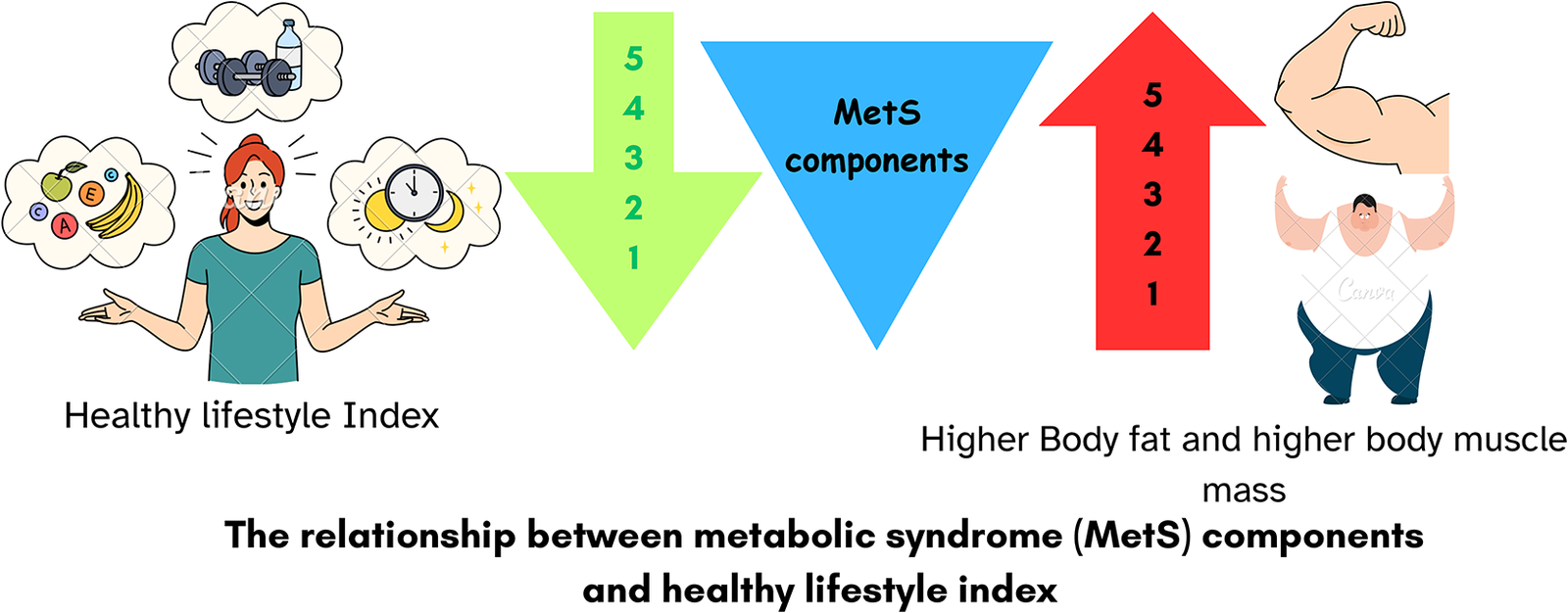Desroches S, Lamarche B. The evolving definitions and increasing prevalence of the metabolic syndrome. Appl Physiol Nutr Metab. 2007;32(1):23–32.
Rochlani Y, Pothineni NV, Kovelamudi S, Mehta JL. Metabolic syndrome: pathophysiology, management, and modulation by natural compounds. Ther Adv Cardiovasc Dis. 2017;11(8):215–25.
Grundy SM. Adipose tissue and metabolic syndrome: too much, too little or neither. Eur J Clin Invest. 2015;45(11):1209–17.
Alberti KG, Eckel RH, Grundy SM, Zimmet PZ, Cleeman JI, Donato KA, Fruchart J-C, James WPT, Loria CM, Smith SC Jr. Harmonizing the metabolic syndrome: a joint interim statement of the international diabetes federation task force on epidemiology and prevention; National heart, lung, and blood institute; American heart association; world heart federation; international atherosclerosis society; and international association for the study of obesity. Circulation. 2009;120(16):1640–5.
Iqbal SP, Ramadas A, Fatt QK, Shin HL, Onn WY, Kadir KA. Relationship of sociodemographic and lifestyle factors and diet habits with metabolic syndrome (MetS) among three ethnic groups of the Malaysian population. PLoS ONE. 2020;15(3):e0224054.
Chirag Prajapati CP, Falguni Majmudar FM. Diabetes mellitus, obesity, hypertension: risk factors for Metabolic Syndrome. 2014.
Noubiap JJ, Nansseu JR, Lontchi-Yimagou E, Nkeck JR, Nyaga UF, Ngouo AT, Tounouga DN, Tianyi F-L, Foka AJ, Ndoadoumgue AL. Geographic distribution of metabolic syndrome and its components in the general adult population: A meta-analysis of global data from 28 million individuals. Diabetes Res Clin Pract. 2022;188:109924.
You T, Ryan AS, Nicklas BJ. The metabolic syndrome in obese postmenopausal women: relationship to body composition, visceral fat, and inflammation. J Clin Endocrinol Metabolism. 2004;89(11):5517–22. https://doi.org/10.1210/jc.2004-0480.
Liu P, Ma F, Lou H, Liu Y. The utility of fat mass index vs. body mass index and percentage of body fat in the screening of metabolic syndrome. BMC Public Health. 2013;13:1–8.
Kim K, Park SM. Association of muscle mass and fat mass with insulin resistance and the prevalence of metabolic syndrome in Korean adults: a cross-sectional study. Sci Rep. 2018;8(1):2703.
Lee JA, Cha YH, Kim SH, Park HS. Impact of combined lifestyle factors on metabolic syndrome in Korean men. J Public Health. 2017;39(1):82–9.
Chang S-H, Chen M-C, Chien N-H, Wu L-YCE. Original research: examining the links between lifestyle factors and metabolic syndrome. AJN Am J Nurs. 2016;116(12):26–36.
VanWormer JJ, Boucher JL, Sidebottom AC, Sillah A, Knickelbine T. Lifestyle changes and prevention of metabolic syndrome in the heart of new Ulm project. Prev Med Rep. 2017;6:242–5.
Valerio A, Nisoli E, Rossi AP, Pellegrini M, Todesco T, El Ghoch M. Obesity and higher risk for severe complications of Covid-19: what to do when the two pandemics Meet. J Popul Ther Clin Pharmacol. 2020;27(SP1):e31–6.
Mirmiran P, Farhadnejad H, Teymoori F, Parastouei K, Azizi F. The higher adherence to healthy lifestyle factors is associated with a decreased risk of metabolic syndrome in Iranian adults. Nutr Bull. 2022;47(1):57–67.
Morita A, Aiba N, Miyachi M, Watanabe S, Group SCS. The associations of eating behavior and dietary intake with metabolic syndrome in Japanese: Saku cohort baseline study. J Physiol Anthropol. 2020;39:1–11.
Ajlouni K, Khader Y, Alyousfi M, Al Nsour M, Batieha A, Jaddou H. Metabolic syndrome amongst adults in Jordan: prevalence, trend, and its association with socio-demographic characteristics. Diabetol Metab Syndr. 2020;12(1):1–11. https://doi.org/10.1186/s13098-020-00610-7.
McLester CN, Nickerson BS, Kliszczewicz BM, McLester JR. Reliability and agreement of various inbody body composition analyzers as compared to dual-energy X-ray absorptiometry in healthy men and women. J Clin Densitometry. 2020;23(3):443–50.
Bosy-Westphal A, Schautz B, Later W, Kehayias J, Gallagher D, Müller M. What makes a BIA equation unique? Validity of eight-electrode multifrequency BIA to estimate body composition in a healthy adult population. Eur J Clin Nutr. 2013;67(1):S14–21.
Huang J, Nie F, Bi J, International Conference on Social Science, Education Management and Sports Education. Comparison of food consumption score (FCS) and calorie intake indicators to measure food security. 2015: Atlantis Press; 2015. pp. 1152-8.https://www.atlantis-press.com/proceedings/ssemse-15/25842273 Access date:26-June-2024.
Akhavanfar R, Hojati A, Kahrizi MS, Farhangi MA, Ardekani AM. Adherence to lifelines diet score and risk factors of metabolic syndrome among overweight and obese adults: A cross-sectional study. Front Nutr. 2022;9:961468.
Khadem A, Shiraseb F, Mirzababaei A, Ghaffarian-Ensaf R, Mirzaei K. Association of lifelines diet score (LLDS) and metabolically unhealthy overweight/obesity phenotypes in women: a cross-sectional study. BMC Womens Health. 2022;22(1):1–10.
Naudin S, Viallon V, Hashim D, Freisling H, Jenab M, Weiderpass E, Perrier F, McKenzie F, Bueno-de-Mesquita HB, Olsen A. Healthy lifestyle and the risk of pancreatic cancer in the EPIC study. Euro J Epidemiol. 2020;35:975–86.
Hunot C, Fildes A, Croker H, Llewellyn CH, Wardle J, Beeken RJ. Appetitive traits and relationships with BMI in adults: development of the adult eating behaviour questionnaire. Appetite. 2016;105:356–63.
Cohen TR, Kakinami L, Plourde H, Hunot-Alexander C, Beeken RJ. Concurrent validity of the adult eating behavior questionnaire in a Canadian sample. Front Psychol. 2021;12:779041.
Ramazani Y, Moradinazar M, Rezaeian S, Najafi F, Salimi Y. Evaluating the Validity and Reliability of the Persian Version of the Adult Eating Behavior Questionnaire in a Sample of the Iranian Population. 2023.
Freestone S, Ramsay LE. Effect of coffee and cigarette smoking on the blood pressure of untreated and diuretic-treated hypertensive patients. Am J Med. 1982;73(3):348–53.
Eguchi K, Kuruvilla S, Ogedegbe G, Gerin W, Schwartz JE, Pickering TG. What is the optimal interval between successive home blood pressure readings using an automated oscillometric device? J Hypertens. 2009;27(6):1172.
Mancia G, Fagard R, Narkiewicz K, Redon J, Zanchetti A, Bohm M, Christiaens T, Cifkova R, De Backer G, Dominiczak A. 2013 ESH/ESC guidelines for the management of arterial hypertension: the task force for the management of arterial hypertension of the European society of hypertension (ESH) and of the European society of cardiology (ESC). Eur Heart J. 2013;34(28):2159–219.
Nolan PB, Carrick-Ranson G, Stinear JW, Reading SA, Dalleck LC. Prevalence of metabolic syndrome and metabolic syndrome components in young adults: A pooled analysis. Prev Med Rep. 2017;7:211–5. https://doi.org/10.1016/j.pmedr.2017.07.004.
Darroudi S, Fereydouni N, Tayefi M, Ahmadnezhad M, Zamani P, Tayefi B, Kharazmi J, Tavalaie S, Heidari-Bakavoli A, Azarpajouh MR. Oxidative stress and inflammation, two features associated with a high percentage body fat, and that May lead to diabetes mellitus and metabolic syndrome. BioFactors. 2019;45(1):35–42. https://doi.org/10.1002/biof.1459.
Moon JH, Kim JS. The cutoff value in body fat percentage for increased risk of metabolic syndrome in elderly people with normal body weight. J Korean Geriatr Soc. 2015;19(1):16–24.
Wang J, Rennie KL, Gu W, Li H, Yu Z, Lin X. Independent associations of body-size adjusted fat mass and fat-free mass with the metabolic syndrome in Chinese. Ann Hum Biol. 2009;36(1):110–21.
Kwon H, Kim D, Kim JS. Body fat distribution and the risk of incident metabolic syndrome: a longitudinal cohort study. Sci Rep. 2017;7(1):10955.
Ramírez-Vélez R, Correa-Bautista JE, Sanders-Tordecilla A, Ojeda-Pardo ML, Cobo-Mejía EA, Castellanos-Vega RDP, García-Hermoso A, González-Jiménez E, Schmidt-RioValle J, González-Ruíz K. Percentage of body fat and fat mass index as a screening tool for metabolic syndrome prediction in Colombian university students. Nutrients. 2017;9(9):1009.
Shukohifar M, Mozafari Z, Rahmanian M, Mirzaei M. Performance of body mass index and body fat percentage in predicting metabolic syndrome risk factors in diabetic patients of Yazd, Iran. BMC Endocr Disorders. 2022;22(1):216.
Song P, Han P, Zhao Y, Zhang Y, Wang L, Tao Z, Jiang Z, Shen S, Wu Y, Wu J. Muscle mass rather than muscle strength or physical performance is associated with metabolic syndrome in community-dwelling older Chinese adults. BMC Geriatr. 2021;21:1–9.
Kim J-H, Park YS. Low muscle mass is associated with metabolic syndrome in Korean adolescents: the Korea National health and nutrition examination survey 2009–2011. Nutr Res. 2016;36(12):1423–8. https://doi.org/10.1016/j.nutres.2016.09.013.
Lee TY, Jeon Y-J, Kim CR, Kang BJ, Park G-M, editors. Abdominal muscles and metabolic syndrome according to patient sex: A retrospective cross-sectional study. Healthcare: MDPI. Access; 2021.
Niu M, Chen J, Hou R, Sun Y, Xiao Q, Pan X, Zhu X. Emerging healthy lifestyle factors and all-cause mortality among people with metabolic syndrome and metabolic syndrome-like characteristics in NHANES. J Translational Med. 2023;21(1):239.
Garralda-Del-Villar M, Carlos-Chillerón S, Diaz-Gutierrez J, Ruiz-Canela M, Gea A, Martínez-González MA, Bes-Rastrollo M, Ruiz-Estigarribia L, Kales SN, Fernández-Montero A. Healthy lifestyle and incidence of metabolic syndrome in the SUN cohort. Nutrients. 2018;11(1):65.
Vajdi M, Karimi A, Farhangi MA, Ardekani AM. The association between healthy lifestyle score and risk of metabolic syndrome in Iranian adults: a cross-sectional study. BMC Endocr Disorders. 2023;23(1):16.
Sotos-Prieto M, Bhupathiraju SN, Falcón LM, Gao X, Tucker KL, Mattei J. A healthy lifestyle score is associated with cardiometabolic and neuroendocrine risk factors among Puerto Rican adults. J Nutr. 2015;145(7):1531–40.
Buscemi S, Sprini D, Grosso G, Galvano F, Nicolucci A, Lucisano G, Massenti FM, Amodio E, Rini GB. Impact of lifestyle on metabolic syndrome in apparently healthy people. Eating and Weight Disorders-Studies on Anorexia, Bulimia and Obesity. 2014;19:225–32.
Bhanushali CJ, Kumar K, Wutoh AK, Karavatas S, Habib MJ, Daniel M, Lee E. Association between lifestyle factors and metabolic syndrome among African Americans in the United States. Journal of nutrition and metabolism. 2013;2013.
Perona JS, Schmidt-RioValle J, Rueda-Medina B, Correa-Rodríguez M, González-Jiménez E. Waist circumference shows the highest predictive value for metabolic syndrome, and waist-to-hip ratio for its components, in Spanish adolescents. Nutr Res. 2017;45:38–45.
Engin A. The definition and prevalence of obesity and metabolic syndrome. Obes Lipotoxicity. 2017:1–17.
Shah RV, Murthy VL, Abbasi SA, Blankstein R, Kwong RY, Goldfine AB, Jerosch-Herold M, Lima JA, Ding J, Allison MA. Visceral adiposity and the risk of metabolic syndrome across body mass index: the MESA study. JACC: Cardiovasc Imaging. 2014;7(12):1221–35.
Kang SM, Yoon JW, Ahn HY, Kim SY, Lee KH, Shin H, Choi SH, Park KS, Jang HC, Lim S. Android fat depot is more closely associated with metabolic syndrome than abdominal visceral fat in elderly people. PLoS ONE. 2011;6(11):e27694.
Peila R, Rohan TE. The association between the healthy lifestyle index and MRI-derived body composition measurements in the UK biobank study. Sci Rep. 2025;15(1):1010.
Deng Y, Ma T, Ngai FW, Wang HH, Yang L, Sun Q, Xie YJ. Association of a healthy lifestyle index with anthropometric indices and obesity in Hong Kong Chinese women: evidence from the MECH-HK cohort study. Obes Res Clin Pract. 2024;18(6):401–8.
Peila R, Xue X, Qi Q, Dannenberg AJ, Allison MA, Johnson KC, LaMonte MJ, Wild RA, Haring B, Pan K. Healthy lifestyle index and risk of cardiovascular disease among postmenopausal women with normal body mass index. J Am Heart Association. 2023;12(12):e029111.
Lahav Y, Goldstein N, Gepner Y. Comparison of body composition assessment across body mass index categories by two multifrequency bioelectrical impedance analysis devices and dual-energy X-ray absorptiometry in clinical settings. Eur J Clin Nutr. 2021;75(8):1275–82.
Potter AW, Nindl LJ, Soto LD, Pazmino A, Looney DP, Tharion WJ, Robinson-Espinosa JA, Friedl KE. High precision but systematic offset in a standing bioelectrical impedance analysis (BIA) compared with dual-energy X-ray absorptiometry (DXA). BMJ Nutr Prev Health. 2022;5(2):254.































